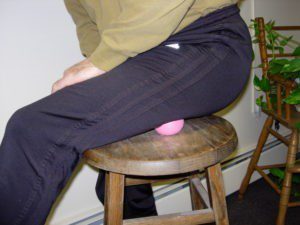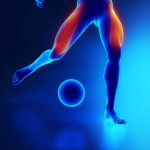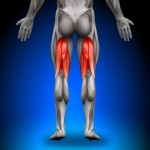Treating Hamstrings To Relax The Pelvis
Author: Julie Donnelly, LMT – The Pain Relief Expert
Editor: Dr. Steve Chaney
Happy Thanksgiving!
 November is the month that reminds us to be grateful for all the blessings we enjoy because we are Americans. Of course, we should be grateful every day for the freedoms we have in this beautiful country! Have you thought about the freedom you enjoy the most?
November is the month that reminds us to be grateful for all the blessings we enjoy because we are Americans. Of course, we should be grateful every day for the freedoms we have in this beautiful country! Have you thought about the freedom you enjoy the most?
For me it’s the freedom to worship however I choose because we don’t have a particular religion forced on us. I also love the fact that I can own my business and move it anywhere I like in the entire country.
I hope you’ll give some thought to what you are grateful for as this happy holiday draws near.
With that said, I want to tell you about a man who drove 17 hours from southern Texas to work with me for a week. Let’s call him JT for privacy.
Can Touch Your Toes?
JT was stiffer than anyone I’d ever seen in the past, and after a 17-hour trip, we knew he needed to come in a LOT. He ended up coming in for 3 hours a day for the first 3 days, and 90 minutes on Thursday and Friday.
When JT arrived, it amazed me at how stiff his pelvis was, every muscle that moved his pelvis, legs and low back were tied up in multiple tight knots. He has given me permission to share his pictures with you so I can explain something interesting that I found, and how it can help you to release tension in your low back.
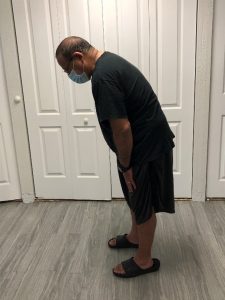 Day 1: JT’s hips were so locked that when he bent forward his fingertips only went to 7” above his knees. He couldn’t bend any further than this!
Day 1: JT’s hips were so locked that when he bent forward his fingertips only went to 7” above his knees. He couldn’t bend any further than this!
I’ve already shown you how to do the self-treatment for your quadriceps using a 12”x1” length of PVC pipe (https://chaneyhealth.com/healthtips/chronic-thigh-muscle-pain-relief/), and how to use the Perfect Ball on your low back muscle (https://chaneyhealth.com/healthtips/do-stretches-for-sciatica-nerve-pain-work/).
This is where we started so the muscles that rotate the pelvis down in the front can start to release.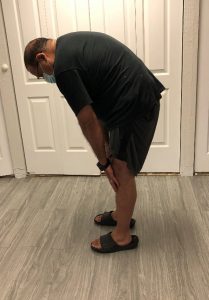
Day 2: First I worked on all of the muscles that insert into his thigh bone where it inserts into his pelvis. Then JT used the Perfect Ball and working on the floor he went deeply into all of the muscles that connect his pelvis to his thigh bone.
At the end of the day his fingers were 5” below his knee joint.
On Day 3 there was a set-back, his fingers were still about 2” below his knee joint but we were questioning what we were missing. When JT bent forward, he had pain in the front of his pelvis, just below the point of his hip bone.
That’s an area that shouldn’t be hurting when JT bent forward. I kept looking at my skeleton, Max, and my book of muscles/bones/joints, to try to figure it out, and looking at the muscles of the pelvis. Then suddenly it was so clear!
Your hamstrings originate at the base of your posterior pelvis, and they insert just below the back of your knee. Your thigh bone (femur) inserts into your hip at an area called the acetabulum, it looks like fitting a ball into a curved cup.
This is the part I want to share with you today.
How Your Hamstrings Impact Your Pelvis
On the afternoon of Day 3, I was frustrated at the set-back. After staring at Max and my book of muscles it finally dawned on me that it was JT’s hamstrings that were part of the problem, even though it was his rotating pelvis that was causing his hip joint to be out of alignment.
I had been working on all the pelvic muscles and they all felt pretty good, and I had done a pass down the back of his thighs, but I hadn’t focused on JT’s hamstrings. And that made all the difference!
An important point to mention when talking about a long-standing problem with tight muscles is to discuss “muscle 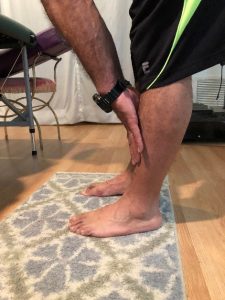 memory.”
memory.”
Muscle memory is when a muscle that has been held shortened for an extended time (which could be just a few hours) it will shorten to that new length. The problem is, you release the tension in the muscles and get relief, but the muscle shortens again, and the strain is again placed on your joints.
As JT’s hamstrings shortened, they pulled down of the back of his pelvis, and this twisted the alignment of his hip joint. Because of this misalignment, he was feeling pain in the front of his hip, and that was the piece I’d been missing.
After treating JT’s hamstrings (treatment shown below) he was able to bend almost all the way to his ankles! Only three days before JT could only bend to not even the middle of his thigh, yet here he was almost to his ankles!
Treating Hamstrings To Relax The Pelvis
If you have been to my therapy office, you know that I always teach how to do 1-2 self-treatments. The reason is you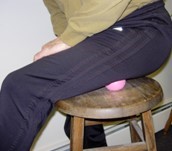 need to reverse muscle memory, and the only way to do that is to do the self-treatments frequently – every day is best.
need to reverse muscle memory, and the only way to do that is to do the self-treatments frequently – every day is best.
A simple way of treating your hamstrings is to put a Perfect Ball on a wooden chair, or the corner of a desk, and put your hamstrings onto the ball.
Keep moving the ball until you find tender points as these are the knots (spasms) that are putting a strain on your pelvis. Treat each point and then stretch
Stretching Your Hamstrings
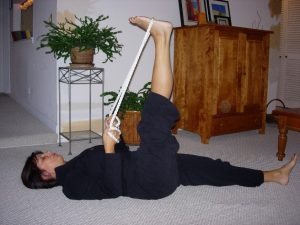 Lie on your back and put a rope under your arch. Start with your knee bent and lift your leg up as high as you can go without seriously straining your hamstrings.
Lie on your back and put a rope under your arch. Start with your knee bent and lift your leg up as high as you can go without seriously straining your hamstrings.
Slowly straighten your leg, stretching your hamstrings.
Day 5 – JT is Ready to Go Back to Texas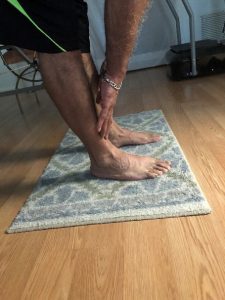
JT is now only 3” above the top of his foot. He’s not touching his toes yet, but he feels so much better.
The best news is that JT is thoroughly familiar with every self-treatment to release all the muscles that have an impact on his pelvis. He’s not 100% better yet, but he’s well on his way.
How Does This Affect You?
The important part of this story for you is that you CAN learn how to self-treat, and the odds are excellent that you can get relief from even the most stubborn of chronic pains.
My goal is to help as many people as possible to eliminate chronic pain that is caused by tight muscles, and to show them how to self-treat!
Wishing you well,
Julie Donnelly
www.FlexibleAthlete.com
These statements have not been evaluated by the Food and Drug Administration. This information is not intended to diagnose, treat, cure, or prevent any disease.
_____________________________________________________________________________
My posts and “Health Tips From the Professor” articles carefully avoid claims about any brand of supplement or manufacturer of supplements. However, I am often asked by representatives of supplement companies if they can share them with their customers.
My answer is, “Yes, as long as you share only the article without any additions or alterations. In particular, you should avoid adding any mention of your company or your company’s products. If you were to do that, you could be making what the FTC and FDA consider a “misleading health claim” that could result in legal action against you and the company you represent.
For more detail about FTC regulations for health claims, see this link.
https://www.ftc.gov/business-guidance/resources/health-products-compliance-guidance
______________________________________________________________________
About The Author
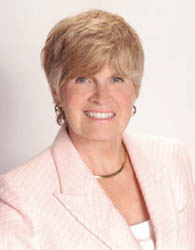 Julie Donnelly has been a licensed massage therapist since 1989, specializing in the treatment of chronic pain and sports injuries. The author of several books including Treat Yourself to Pain-Free Living, The Pain-Free Athlete, and The 15 Minute Back Pain Solution.
Julie Donnelly has been a licensed massage therapist since 1989, specializing in the treatment of chronic pain and sports injuries. The author of several books including Treat Yourself to Pain-Free Living, The Pain-Free Athlete, and The 15 Minute Back Pain Solution.
Julie has also developed a proven self-treatment program for the symptoms of carpal tunnel syndrome.
She has a therapy practice in Sarasota, Florida, and she travels around the USA to teach massage and physical therapists how to do the Julstro Method, and she also teaches self-treatment clinics to anyone interested in taking charge of their own health and flexibility.
She may be reached at her office: 919-886-1861, or through her website: www.FlexibleAthlete.com
About The Editor
 Dr. Chaney has a BS in Chemistry from Duke University and a PhD in Biochemistry from UCLA. He is Professor Emeritus from the University of North Carolina where he taught biochemistry and nutrition to medical and dental students for 40 years.
Dr. Chaney has a BS in Chemistry from Duke University and a PhD in Biochemistry from UCLA. He is Professor Emeritus from the University of North Carolina where he taught biochemistry and nutrition to medical and dental students for 40 years.
Dr. Chaney won numerous teaching awards at UNC, including the Academy of Educators “Excellence in Teaching Lifetime Achievement Award”. Dr Chaney also ran an active cancer research program at UNC and published over 100 scientific articles and reviews in peer-reviewed scientific journals. In addition, he authored two chapters on nutrition in one of the leading biochemistry text books for medical students.
Since retiring from the University of North Carolina, he has been writing a weekly health blog called “Health Tips From the Professor”. He has also written two best-selling books, “Slaying the Food Myths” and “Slaying the Supplement Myths”. And most recently he has created an online lifestyle change course, “Create Your Personal Health Zone”. For more information visit https://chaneyhealth.com.
For the past 45 years Dr. Chaney and his wife Suzanne have been helping people improve their health holistically through a combination of good diet, exercise, weight control and appropriate supplementation.


